Accounting Thought: Contemporary Issues, Normative Theories, Framework
VerifiedAdded on 2020/02/24
|9
|2342
|140
Essay
AI Summary
This paper offers a comprehensive analysis of contemporary issues in accounting, focusing on the conceptual framework, normative theories, and their practical implications. The first essay delves into the qualitative characteristics of accounting, as defined by the conceptual framework, including relevance, reliability, comparability, and understandability, and links these characteristics to the objectives of general-purpose financial reporting and the intended users of financial information. The second essay explores normative theories in accounting, particularly contrasting Historic Cost Accounting (HCA) with its alternatives, such as Constant Purchasing Power Accounting (CPPA) and Fair Value Accounting (FVA), evaluating their strengths and weaknesses. The final essay discusses the building blocks of the conceptual framework, including the objectives of financial reporting, the qualities of financial information, the elements of financial statements, and recognition and measurement, while also providing an assessment of the framework's advantages and criticisms. The paper concludes by emphasizing the importance of the conceptual framework in ensuring transparency in business operations.
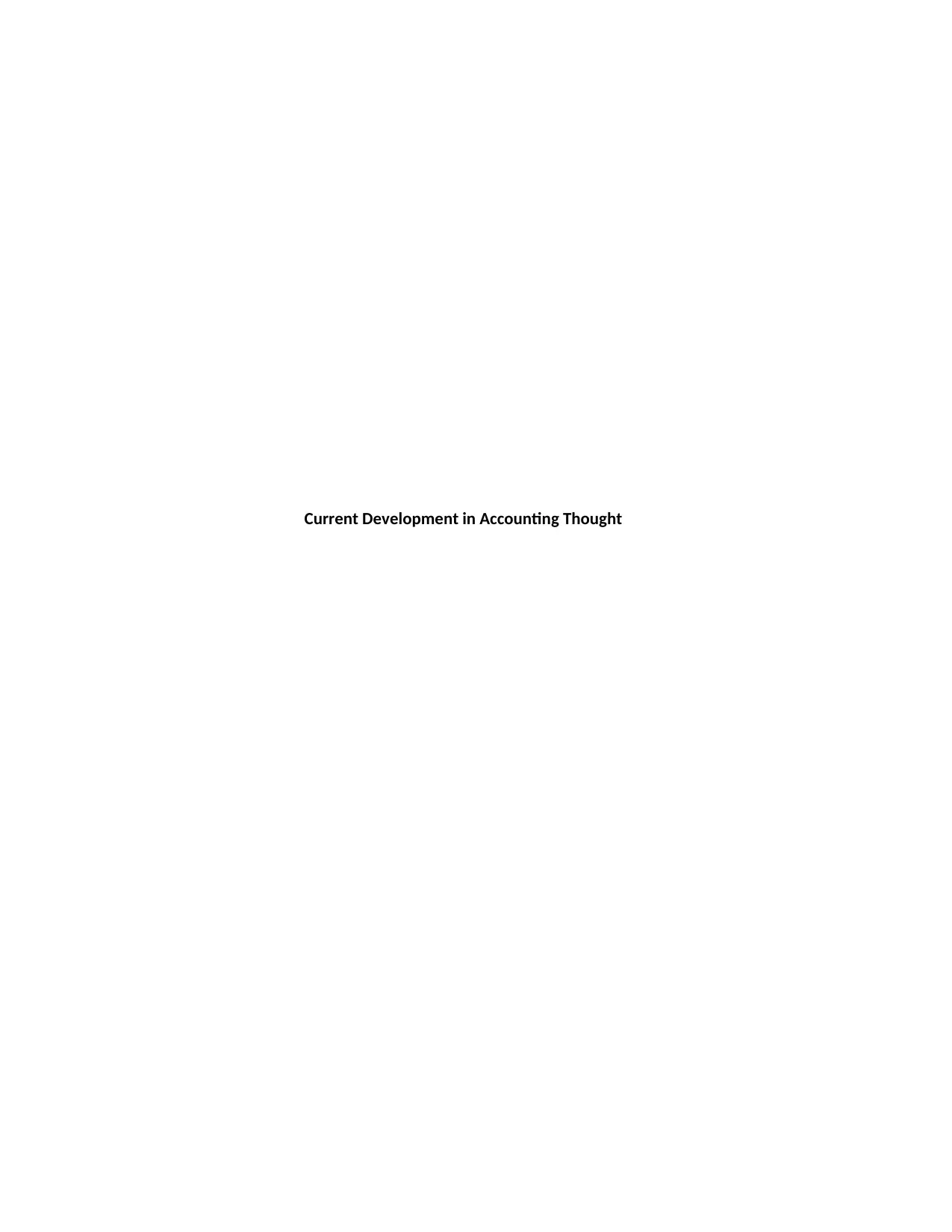
Current Development in Accounting Thought
Paraphrase This Document
Need a fresh take? Get an instant paraphrase of this document with our AI Paraphraser
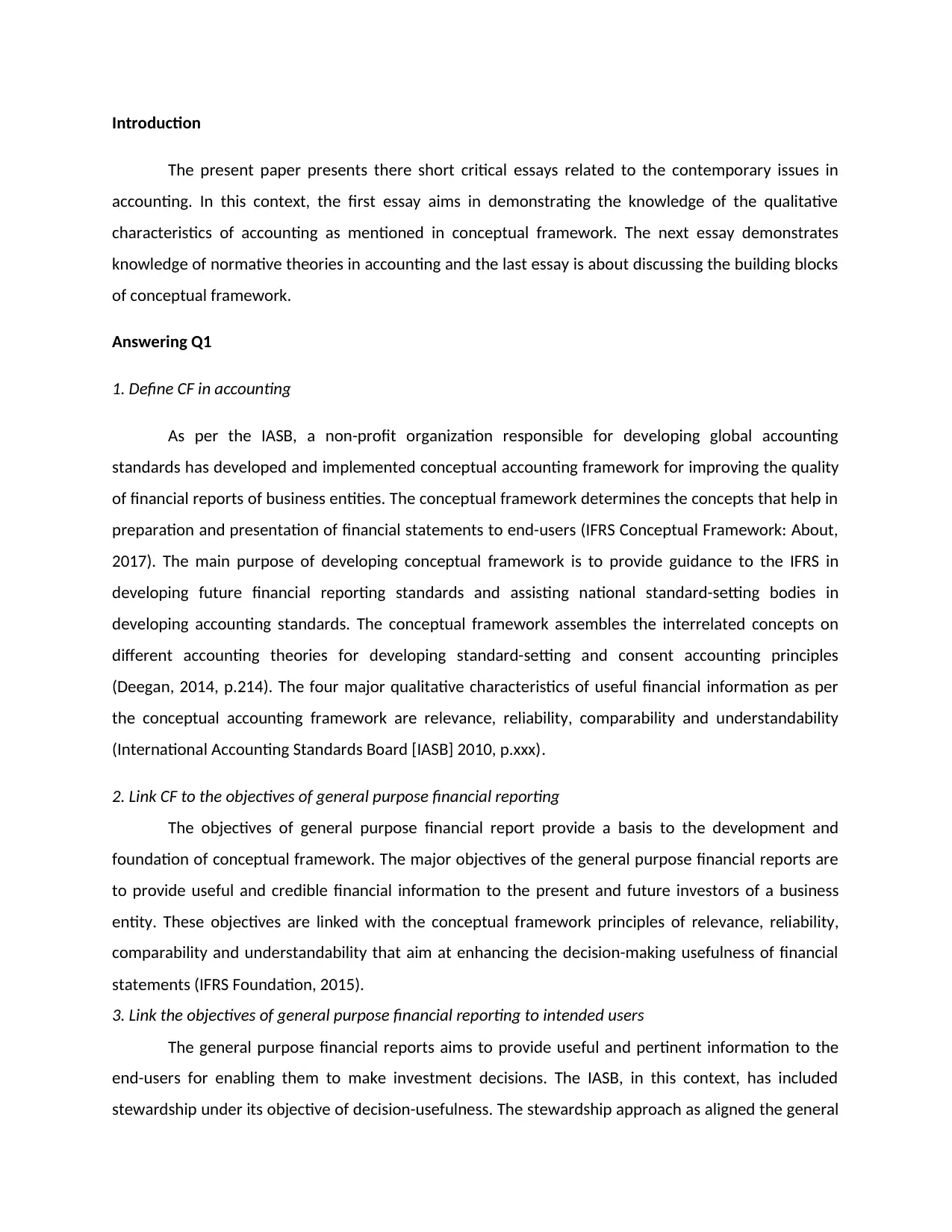
Introduction
The present paper presents there short critical essays related to the contemporary issues in
accounting. In this context, the first essay aims in demonstrating the knowledge of the qualitative
characteristics of accounting as mentioned in conceptual framework. The next essay demonstrates
knowledge of normative theories in accounting and the last essay is about discussing the building blocks
of conceptual framework.
Answering Q1
1. Define CF in accounting
As per the IASB, a non-profit organization responsible for developing global accounting
standards has developed and implemented conceptual accounting framework for improving the quality
of financial reports of business entities. The conceptual framework determines the concepts that help in
preparation and presentation of financial statements to end-users (IFRS Conceptual Framework: About,
2017). The main purpose of developing conceptual framework is to provide guidance to the IFRS in
developing future financial reporting standards and assisting national standard-setting bodies in
developing accounting standards. The conceptual framework assembles the interrelated concepts on
different accounting theories for developing standard-setting and consent accounting principles
(Deegan, 2014, p.214). The four major qualitative characteristics of useful financial information as per
the conceptual accounting framework are relevance, reliability, comparability and understandability
(International Accounting Standards Board [IASB] 2010, p.xxx).
2. Link CF to the objectives of general purpose financial reporting
The objectives of general purpose financial report provide a basis to the development and
foundation of conceptual framework. The major objectives of the general purpose financial reports are
to provide useful and credible financial information to the present and future investors of a business
entity. These objectives are linked with the conceptual framework principles of relevance, reliability,
comparability and understandability that aim at enhancing the decision-making usefulness of financial
statements (IFRS Foundation, 2015).
3. Link the objectives of general purpose financial reporting to intended users
The general purpose financial reports aims to provide useful and pertinent information to the
end-users for enabling them to make investment decisions. The IASB, in this context, has included
stewardship under its objective of decision-usefulness. The stewardship approach as aligned the general
The present paper presents there short critical essays related to the contemporary issues in
accounting. In this context, the first essay aims in demonstrating the knowledge of the qualitative
characteristics of accounting as mentioned in conceptual framework. The next essay demonstrates
knowledge of normative theories in accounting and the last essay is about discussing the building blocks
of conceptual framework.
Answering Q1
1. Define CF in accounting
As per the IASB, a non-profit organization responsible for developing global accounting
standards has developed and implemented conceptual accounting framework for improving the quality
of financial reports of business entities. The conceptual framework determines the concepts that help in
preparation and presentation of financial statements to end-users (IFRS Conceptual Framework: About,
2017). The main purpose of developing conceptual framework is to provide guidance to the IFRS in
developing future financial reporting standards and assisting national standard-setting bodies in
developing accounting standards. The conceptual framework assembles the interrelated concepts on
different accounting theories for developing standard-setting and consent accounting principles
(Deegan, 2014, p.214). The four major qualitative characteristics of useful financial information as per
the conceptual accounting framework are relevance, reliability, comparability and understandability
(International Accounting Standards Board [IASB] 2010, p.xxx).
2. Link CF to the objectives of general purpose financial reporting
The objectives of general purpose financial report provide a basis to the development and
foundation of conceptual framework. The major objectives of the general purpose financial reports are
to provide useful and credible financial information to the present and future investors of a business
entity. These objectives are linked with the conceptual framework principles of relevance, reliability,
comparability and understandability that aim at enhancing the decision-making usefulness of financial
statements (IFRS Foundation, 2015).
3. Link the objectives of general purpose financial reporting to intended users
The general purpose financial reports aims to provide useful and pertinent information to the
end-users for enabling them to make investment decisions. The IASB, in this context, has included
stewardship under its objective of decision-usefulness. The stewardship approach as aligned the general
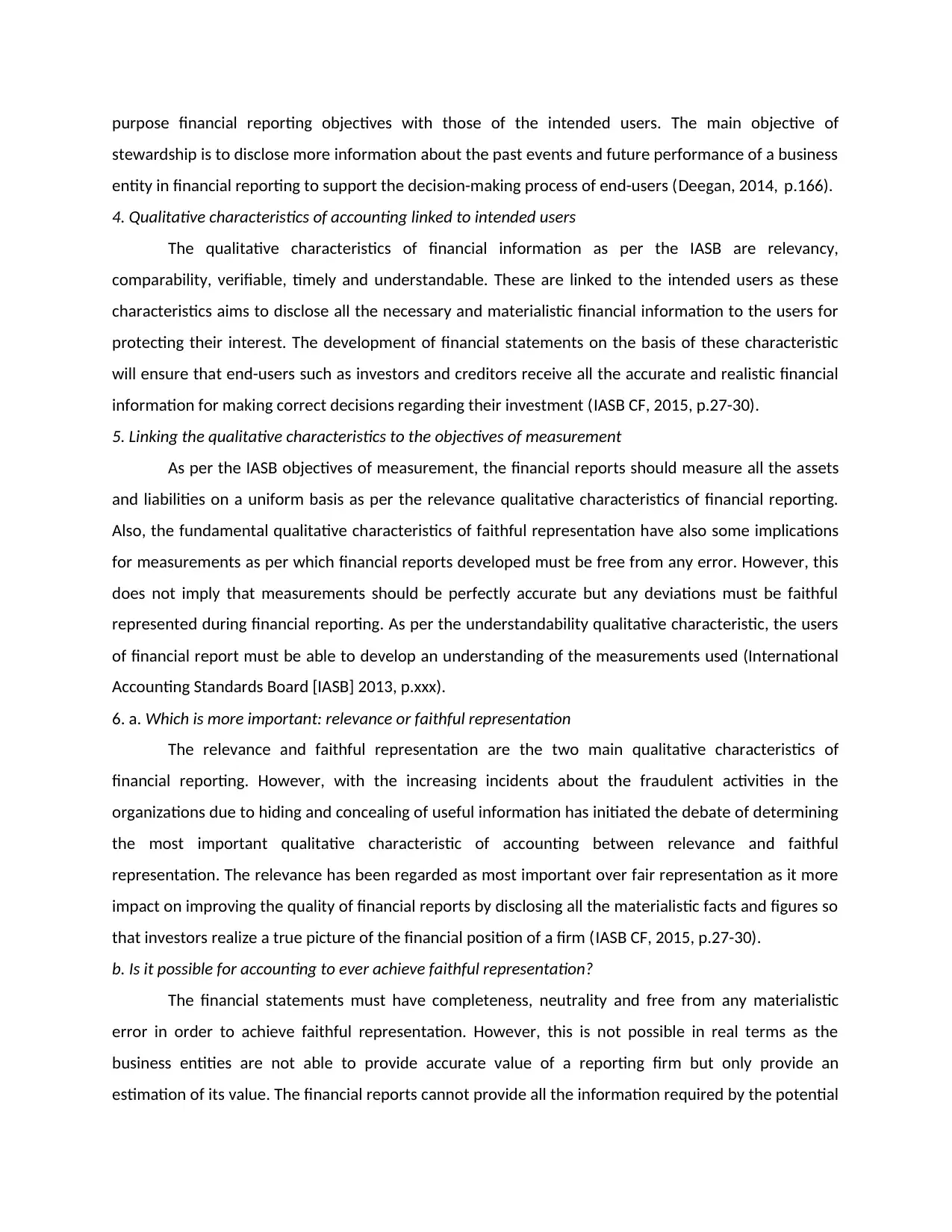
purpose financial reporting objectives with those of the intended users. The main objective of
stewardship is to disclose more information about the past events and future performance of a business
entity in financial reporting to support the decision-making process of end-users (Deegan, 2014, p.166).
4. Qualitative characteristics of accounting linked to intended users
The qualitative characteristics of financial information as per the IASB are relevancy,
comparability, verifiable, timely and understandable. These are linked to the intended users as these
characteristics aims to disclose all the necessary and materialistic financial information to the users for
protecting their interest. The development of financial statements on the basis of these characteristic
will ensure that end-users such as investors and creditors receive all the accurate and realistic financial
information for making correct decisions regarding their investment (IASB CF, 2015, p.27-30).
5. Linking the qualitative characteristics to the objectives of measurement
As per the IASB objectives of measurement, the financial reports should measure all the assets
and liabilities on a uniform basis as per the relevance qualitative characteristics of financial reporting.
Also, the fundamental qualitative characteristics of faithful representation have also some implications
for measurements as per which financial reports developed must be free from any error. However, this
does not imply that measurements should be perfectly accurate but any deviations must be faithful
represented during financial reporting. As per the understandability qualitative characteristic, the users
of financial report must be able to develop an understanding of the measurements used (International
Accounting Standards Board [IASB] 2013, p.xxx).
6. a. Which is more important: relevance or faithful representation
The relevance and faithful representation are the two main qualitative characteristics of
financial reporting. However, with the increasing incidents about the fraudulent activities in the
organizations due to hiding and concealing of useful information has initiated the debate of determining
the most important qualitative characteristic of accounting between relevance and faithful
representation. The relevance has been regarded as most important over fair representation as it more
impact on improving the quality of financial reports by disclosing all the materialistic facts and figures so
that investors realize a true picture of the financial position of a firm (IASB CF, 2015, p.27-30).
b. Is it possible for accounting to ever achieve faithful representation?
The financial statements must have completeness, neutrality and free from any materialistic
error in order to achieve faithful representation. However, this is not possible in real terms as the
business entities are not able to provide accurate value of a reporting firm but only provide an
estimation of its value. The financial reports cannot provide all the information required by the potential
stewardship is to disclose more information about the past events and future performance of a business
entity in financial reporting to support the decision-making process of end-users (Deegan, 2014, p.166).
4. Qualitative characteristics of accounting linked to intended users
The qualitative characteristics of financial information as per the IASB are relevancy,
comparability, verifiable, timely and understandable. These are linked to the intended users as these
characteristics aims to disclose all the necessary and materialistic financial information to the users for
protecting their interest. The development of financial statements on the basis of these characteristic
will ensure that end-users such as investors and creditors receive all the accurate and realistic financial
information for making correct decisions regarding their investment (IASB CF, 2015, p.27-30).
5. Linking the qualitative characteristics to the objectives of measurement
As per the IASB objectives of measurement, the financial reports should measure all the assets
and liabilities on a uniform basis as per the relevance qualitative characteristics of financial reporting.
Also, the fundamental qualitative characteristics of faithful representation have also some implications
for measurements as per which financial reports developed must be free from any error. However, this
does not imply that measurements should be perfectly accurate but any deviations must be faithful
represented during financial reporting. As per the understandability qualitative characteristic, the users
of financial report must be able to develop an understanding of the measurements used (International
Accounting Standards Board [IASB] 2013, p.xxx).
6. a. Which is more important: relevance or faithful representation
The relevance and faithful representation are the two main qualitative characteristics of
financial reporting. However, with the increasing incidents about the fraudulent activities in the
organizations due to hiding and concealing of useful information has initiated the debate of determining
the most important qualitative characteristic of accounting between relevance and faithful
representation. The relevance has been regarded as most important over fair representation as it more
impact on improving the quality of financial reports by disclosing all the materialistic facts and figures so
that investors realize a true picture of the financial position of a firm (IASB CF, 2015, p.27-30).
b. Is it possible for accounting to ever achieve faithful representation?
The financial statements must have completeness, neutrality and free from any materialistic
error in order to achieve faithful representation. However, this is not possible in real terms as the
business entities are not able to provide accurate value of a reporting firm but only provide an
estimation of its value. The financial reports cannot provide all the information required by the potential
⊘ This is a preview!⊘
Do you want full access?
Subscribe today to unlock all pages.

Trusted by 1+ million students worldwide
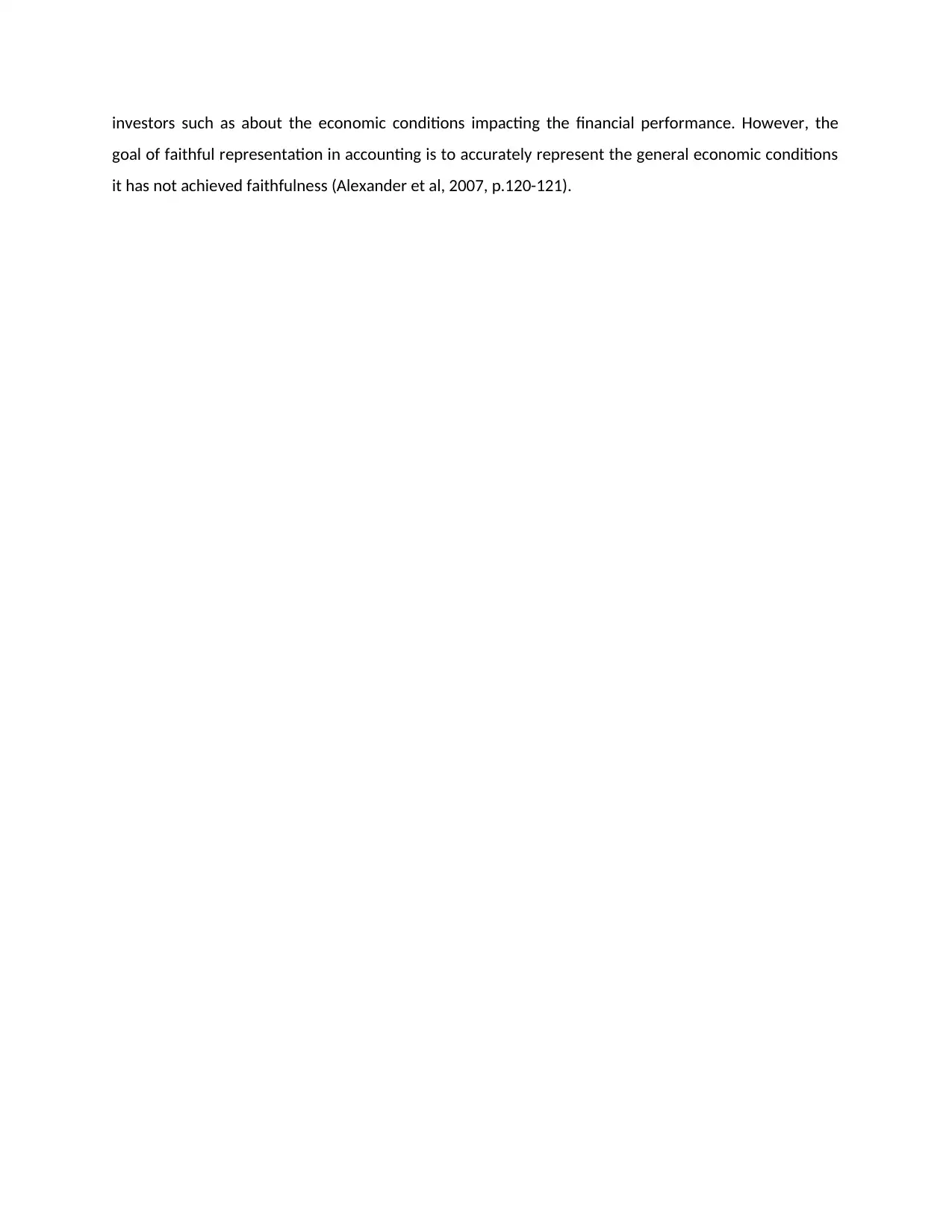
investors such as about the economic conditions impacting the financial performance. However, the
goal of faithful representation in accounting is to accurately represent the general economic conditions
it has not achieved faithfulness (Alexander et al, 2007, p.120-121).
goal of faithful representation in accounting is to accurately represent the general economic conditions
it has not achieved faithfulness (Alexander et al, 2007, p.120-121).
Paraphrase This Document
Need a fresh take? Get an instant paraphrase of this document with our AI Paraphraser
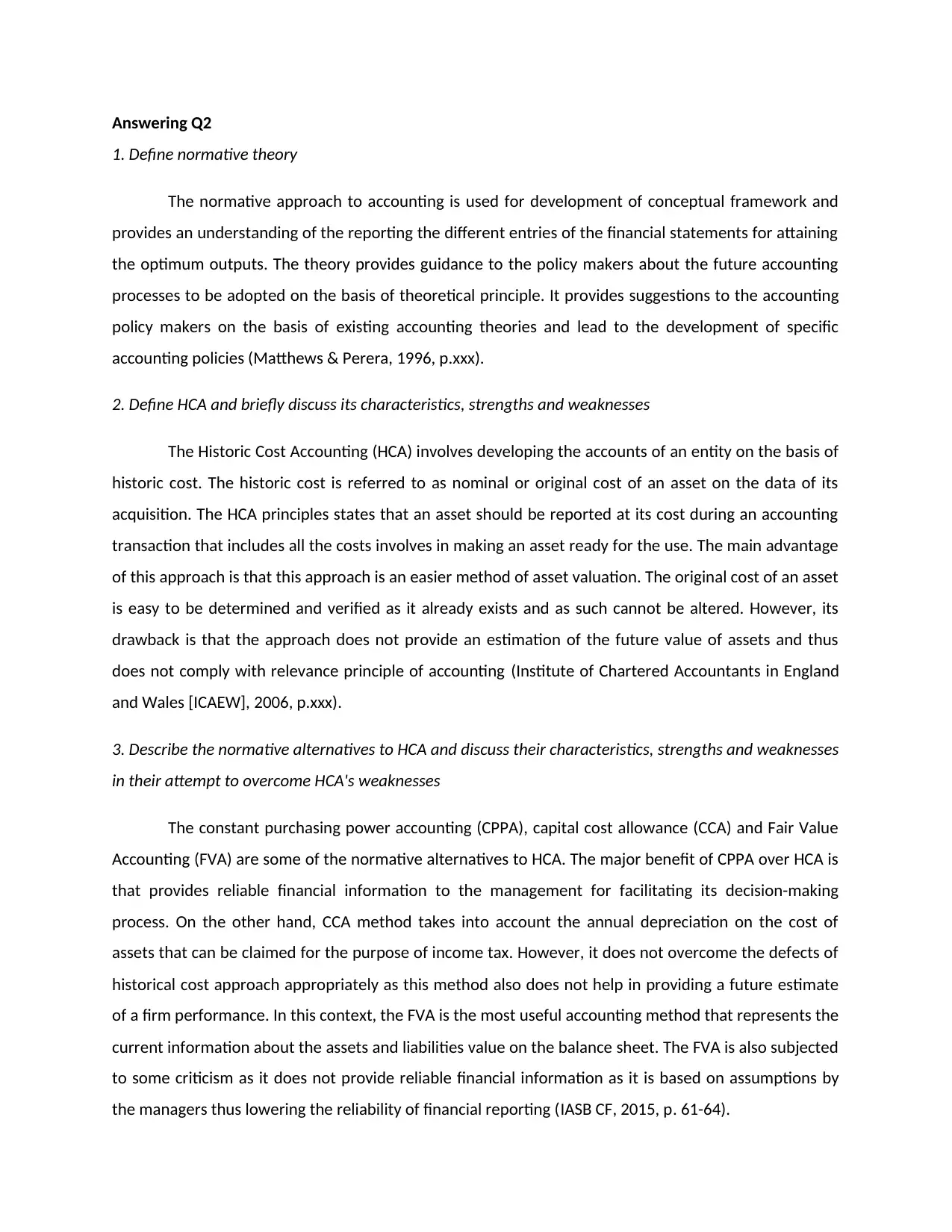
Answering Q2
1. Define normative theory
The normative approach to accounting is used for development of conceptual framework and
provides an understanding of the reporting the different entries of the financial statements for attaining
the optimum outputs. The theory provides guidance to the policy makers about the future accounting
processes to be adopted on the basis of theoretical principle. It provides suggestions to the accounting
policy makers on the basis of existing accounting theories and lead to the development of specific
accounting policies (Matthews & Perera, 1996, p.xxx).
2. Define HCA and briefly discuss its characteristics, strengths and weaknesses
The Historic Cost Accounting (HCA) involves developing the accounts of an entity on the basis of
historic cost. The historic cost is referred to as nominal or original cost of an asset on the data of its
acquisition. The HCA principles states that an asset should be reported at its cost during an accounting
transaction that includes all the costs involves in making an asset ready for the use. The main advantage
of this approach is that this approach is an easier method of asset valuation. The original cost of an asset
is easy to be determined and verified as it already exists and as such cannot be altered. However, its
drawback is that the approach does not provide an estimation of the future value of assets and thus
does not comply with relevance principle of accounting (Institute of Chartered Accountants in England
and Wales [ICAEW], 2006, p.xxx).
3. Describe the normative alternatives to HCA and discuss their characteristics, strengths and weaknesses
in their attempt to overcome HCA's weaknesses
The constant purchasing power accounting (CPPA), capital cost allowance (CCA) and Fair Value
Accounting (FVA) are some of the normative alternatives to HCA. The major benefit of CPPA over HCA is
that provides reliable financial information to the management for facilitating its decision-making
process. On the other hand, CCA method takes into account the annual depreciation on the cost of
assets that can be claimed for the purpose of income tax. However, it does not overcome the defects of
historical cost approach appropriately as this method also does not help in providing a future estimate
of a firm performance. In this context, the FVA is the most useful accounting method that represents the
current information about the assets and liabilities value on the balance sheet. The FVA is also subjected
to some criticism as it does not provide reliable financial information as it is based on assumptions by
the managers thus lowering the reliability of financial reporting (IASB CF, 2015, p. 61-64).
1. Define normative theory
The normative approach to accounting is used for development of conceptual framework and
provides an understanding of the reporting the different entries of the financial statements for attaining
the optimum outputs. The theory provides guidance to the policy makers about the future accounting
processes to be adopted on the basis of theoretical principle. It provides suggestions to the accounting
policy makers on the basis of existing accounting theories and lead to the development of specific
accounting policies (Matthews & Perera, 1996, p.xxx).
2. Define HCA and briefly discuss its characteristics, strengths and weaknesses
The Historic Cost Accounting (HCA) involves developing the accounts of an entity on the basis of
historic cost. The historic cost is referred to as nominal or original cost of an asset on the data of its
acquisition. The HCA principles states that an asset should be reported at its cost during an accounting
transaction that includes all the costs involves in making an asset ready for the use. The main advantage
of this approach is that this approach is an easier method of asset valuation. The original cost of an asset
is easy to be determined and verified as it already exists and as such cannot be altered. However, its
drawback is that the approach does not provide an estimation of the future value of assets and thus
does not comply with relevance principle of accounting (Institute of Chartered Accountants in England
and Wales [ICAEW], 2006, p.xxx).
3. Describe the normative alternatives to HCA and discuss their characteristics, strengths and weaknesses
in their attempt to overcome HCA's weaknesses
The constant purchasing power accounting (CPPA), capital cost allowance (CCA) and Fair Value
Accounting (FVA) are some of the normative alternatives to HCA. The major benefit of CPPA over HCA is
that provides reliable financial information to the management for facilitating its decision-making
process. On the other hand, CCA method takes into account the annual depreciation on the cost of
assets that can be claimed for the purpose of income tax. However, it does not overcome the defects of
historical cost approach appropriately as this method also does not help in providing a future estimate
of a firm performance. In this context, the FVA is the most useful accounting method that represents the
current information about the assets and liabilities value on the balance sheet. The FVA is also subjected
to some criticism as it does not provide reliable financial information as it is based on assumptions by
the managers thus lowering the reliability of financial reporting (IASB CF, 2015, p. 61-64).
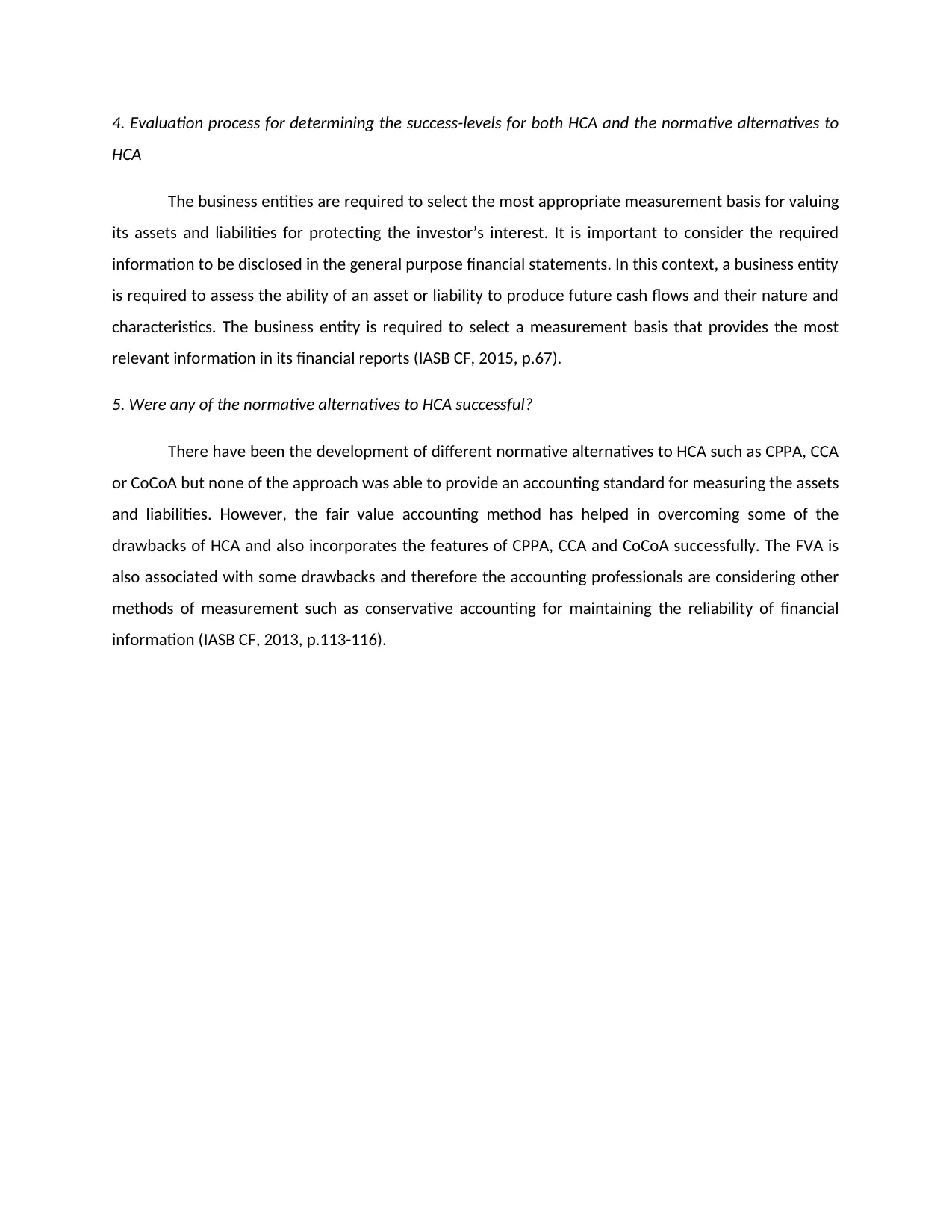
4. Evaluation process for determining the success-levels for both HCA and the normative alternatives to
HCA
The business entities are required to select the most appropriate measurement basis for valuing
its assets and liabilities for protecting the investor’s interest. It is important to consider the required
information to be disclosed in the general purpose financial statements. In this context, a business entity
is required to assess the ability of an asset or liability to produce future cash flows and their nature and
characteristics. The business entity is required to select a measurement basis that provides the most
relevant information in its financial reports (IASB CF, 2015, p.67).
5. Were any of the normative alternatives to HCA successful?
There have been the development of different normative alternatives to HCA such as CPPA, CCA
or CoCoA but none of the approach was able to provide an accounting standard for measuring the assets
and liabilities. However, the fair value accounting method has helped in overcoming some of the
drawbacks of HCA and also incorporates the features of CPPA, CCA and CoCoA successfully. The FVA is
also associated with some drawbacks and therefore the accounting professionals are considering other
methods of measurement such as conservative accounting for maintaining the reliability of financial
information (IASB CF, 2013, p.113-116).
HCA
The business entities are required to select the most appropriate measurement basis for valuing
its assets and liabilities for protecting the investor’s interest. It is important to consider the required
information to be disclosed in the general purpose financial statements. In this context, a business entity
is required to assess the ability of an asset or liability to produce future cash flows and their nature and
characteristics. The business entity is required to select a measurement basis that provides the most
relevant information in its financial reports (IASB CF, 2015, p.67).
5. Were any of the normative alternatives to HCA successful?
There have been the development of different normative alternatives to HCA such as CPPA, CCA
or CoCoA but none of the approach was able to provide an accounting standard for measuring the assets
and liabilities. However, the fair value accounting method has helped in overcoming some of the
drawbacks of HCA and also incorporates the features of CPPA, CCA and CoCoA successfully. The FVA is
also associated with some drawbacks and therefore the accounting professionals are considering other
methods of measurement such as conservative accounting for maintaining the reliability of financial
information (IASB CF, 2013, p.113-116).
⊘ This is a preview!⊘
Do you want full access?
Subscribe today to unlock all pages.

Trusted by 1+ million students worldwide
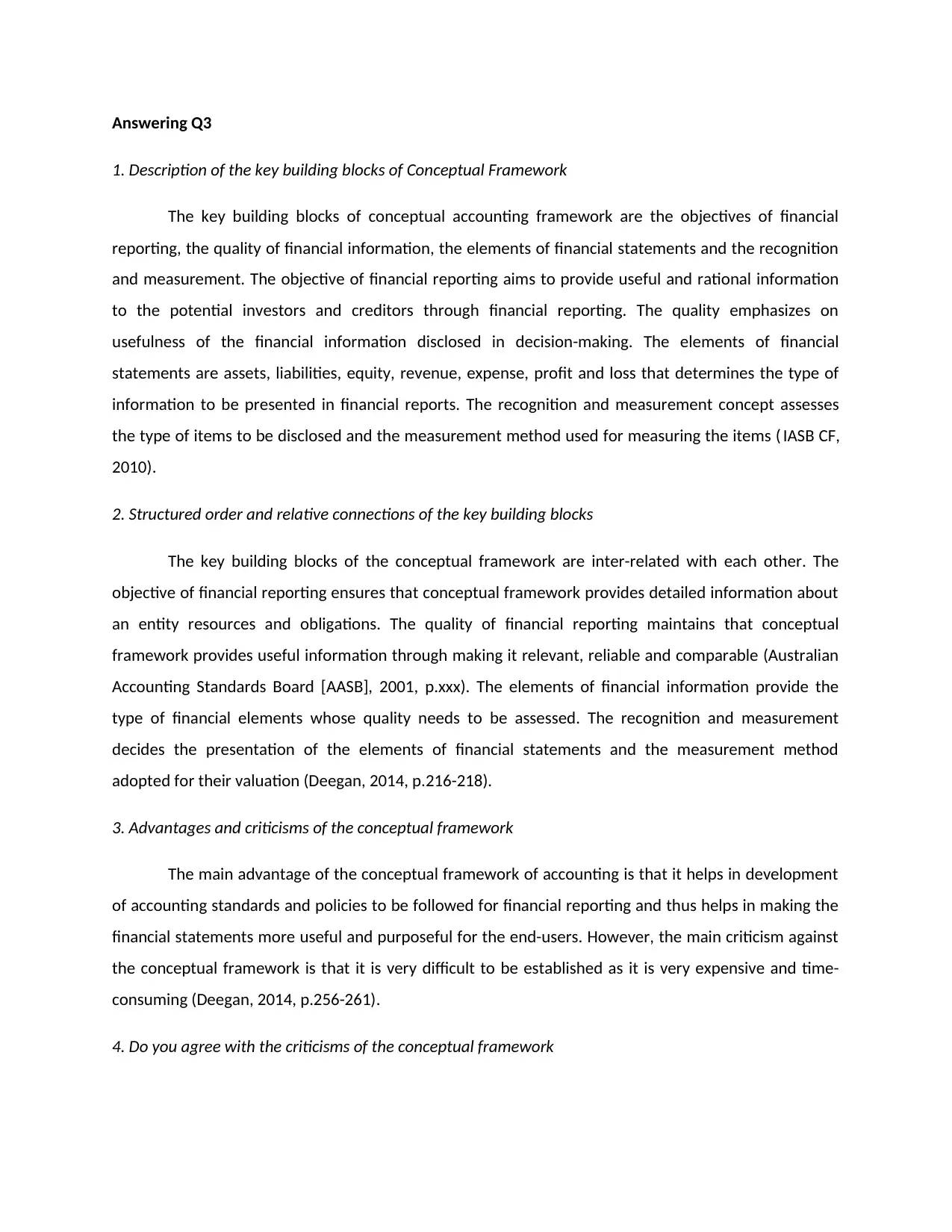
Answering Q3
1. Description of the key building blocks of Conceptual Framework
The key building blocks of conceptual accounting framework are the objectives of financial
reporting, the quality of financial information, the elements of financial statements and the recognition
and measurement. The objective of financial reporting aims to provide useful and rational information
to the potential investors and creditors through financial reporting. The quality emphasizes on
usefulness of the financial information disclosed in decision-making. The elements of financial
statements are assets, liabilities, equity, revenue, expense, profit and loss that determines the type of
information to be presented in financial reports. The recognition and measurement concept assesses
the type of items to be disclosed and the measurement method used for measuring the items ( IASB CF,
2010).
2. Structured order and relative connections of the key building blocks
The key building blocks of the conceptual framework are inter-related with each other. The
objective of financial reporting ensures that conceptual framework provides detailed information about
an entity resources and obligations. The quality of financial reporting maintains that conceptual
framework provides useful information through making it relevant, reliable and comparable (Australian
Accounting Standards Board [AASB], 2001, p.xxx). The elements of financial information provide the
type of financial elements whose quality needs to be assessed. The recognition and measurement
decides the presentation of the elements of financial statements and the measurement method
adopted for their valuation (Deegan, 2014, p.216-218).
3. Advantages and criticisms of the conceptual framework
The main advantage of the conceptual framework of accounting is that it helps in development
of accounting standards and policies to be followed for financial reporting and thus helps in making the
financial statements more useful and purposeful for the end-users. However, the main criticism against
the conceptual framework is that it is very difficult to be established as it is very expensive and time-
consuming (Deegan, 2014, p.256-261).
4. Do you agree with the criticisms of the conceptual framework
1. Description of the key building blocks of Conceptual Framework
The key building blocks of conceptual accounting framework are the objectives of financial
reporting, the quality of financial information, the elements of financial statements and the recognition
and measurement. The objective of financial reporting aims to provide useful and rational information
to the potential investors and creditors through financial reporting. The quality emphasizes on
usefulness of the financial information disclosed in decision-making. The elements of financial
statements are assets, liabilities, equity, revenue, expense, profit and loss that determines the type of
information to be presented in financial reports. The recognition and measurement concept assesses
the type of items to be disclosed and the measurement method used for measuring the items ( IASB CF,
2010).
2. Structured order and relative connections of the key building blocks
The key building blocks of the conceptual framework are inter-related with each other. The
objective of financial reporting ensures that conceptual framework provides detailed information about
an entity resources and obligations. The quality of financial reporting maintains that conceptual
framework provides useful information through making it relevant, reliable and comparable (Australian
Accounting Standards Board [AASB], 2001, p.xxx). The elements of financial information provide the
type of financial elements whose quality needs to be assessed. The recognition and measurement
decides the presentation of the elements of financial statements and the measurement method
adopted for their valuation (Deegan, 2014, p.216-218).
3. Advantages and criticisms of the conceptual framework
The main advantage of the conceptual framework of accounting is that it helps in development
of accounting standards and policies to be followed for financial reporting and thus helps in making the
financial statements more useful and purposeful for the end-users. However, the main criticism against
the conceptual framework is that it is very difficult to be established as it is very expensive and time-
consuming (Deegan, 2014, p.256-261).
4. Do you agree with the criticisms of the conceptual framework
Paraphrase This Document
Need a fresh take? Get an instant paraphrase of this document with our AI Paraphraser
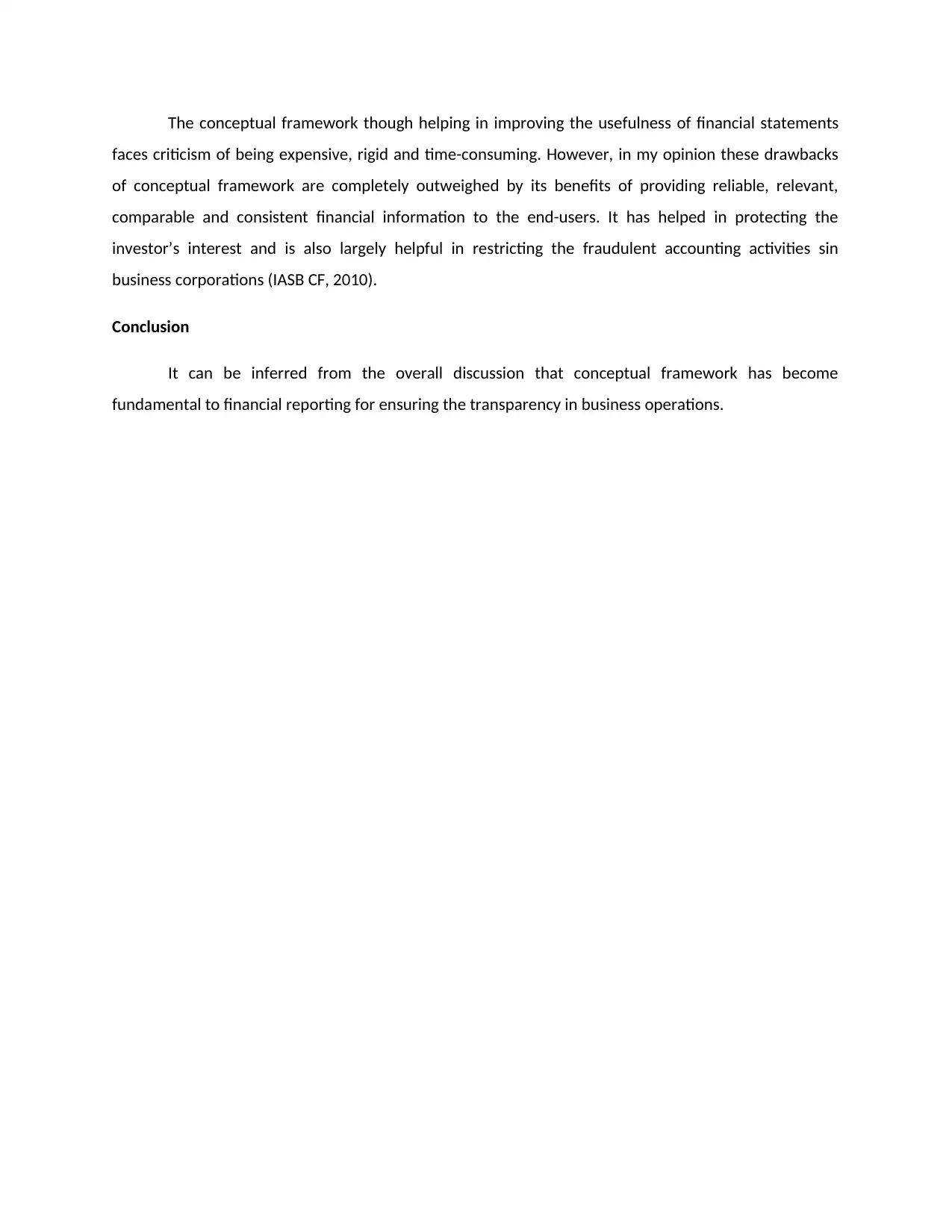
The conceptual framework though helping in improving the usefulness of financial statements
faces criticism of being expensive, rigid and time-consuming. However, in my opinion these drawbacks
of conceptual framework are completely outweighed by its benefits of providing reliable, relevant,
comparable and consistent financial information to the end-users. It has helped in protecting the
investor’s interest and is also largely helpful in restricting the fraudulent accounting activities sin
business corporations (IASB CF, 2010).
Conclusion
It can be inferred from the overall discussion that conceptual framework has become
fundamental to financial reporting for ensuring the transparency in business operations.
faces criticism of being expensive, rigid and time-consuming. However, in my opinion these drawbacks
of conceptual framework are completely outweighed by its benefits of providing reliable, relevant,
comparable and consistent financial information to the end-users. It has helped in protecting the
investor’s interest and is also largely helpful in restricting the fraudulent accounting activities sin
business corporations (IASB CF, 2010).
Conclusion
It can be inferred from the overall discussion that conceptual framework has become
fundamental to financial reporting for ensuring the transparency in business operations.
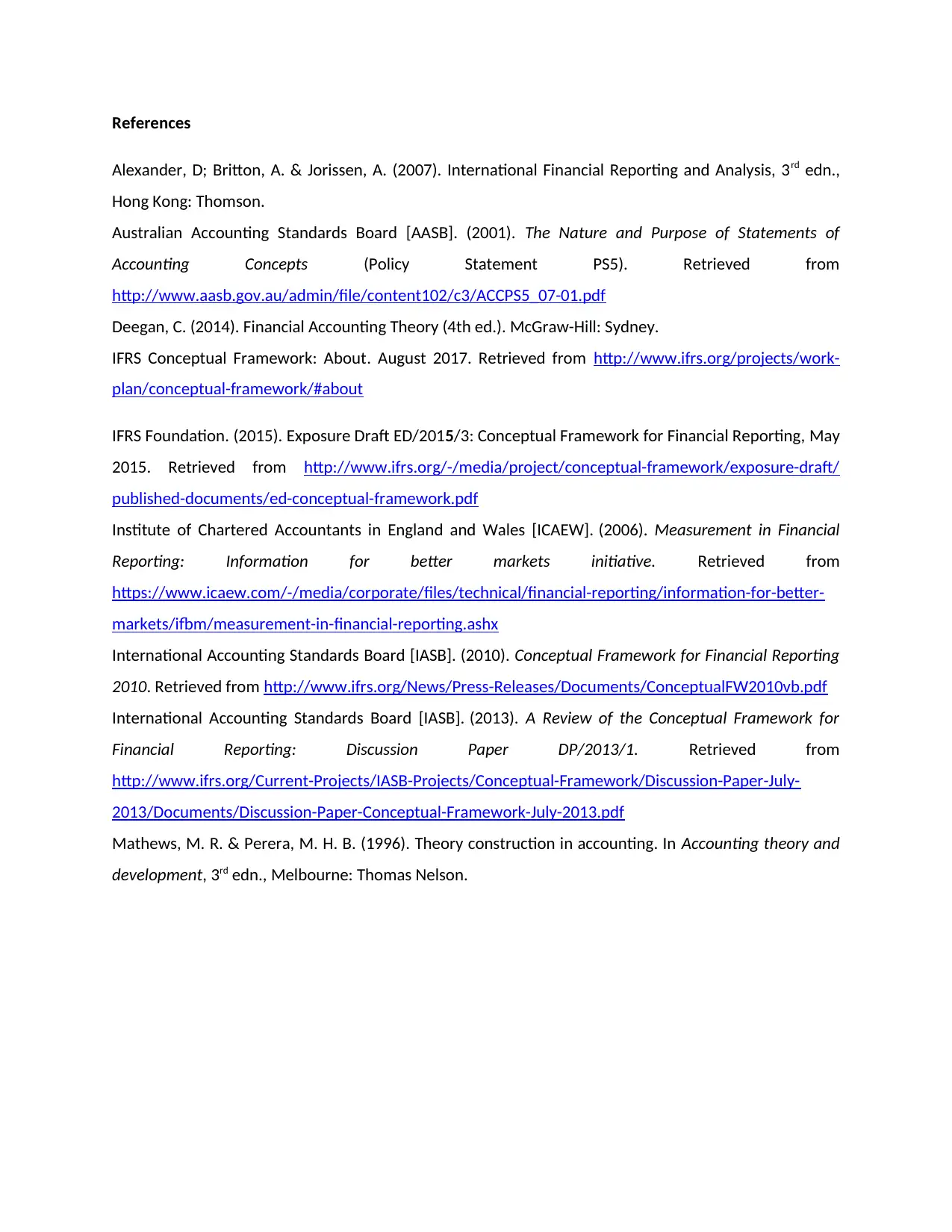
References
Alexander, D; Britton, A. & Jorissen, A. (2007). International Financial Reporting and Analysis, 3rd edn.,
Hong Kong: Thomson.
Australian Accounting Standards Board [AASB]. (2001). The Nature and Purpose of Statements of
Accounting Concepts (Policy Statement PS5). Retrieved from
http://www.aasb.gov.au/admin/file/content102/c3/ACCPS5_07-01.pdf
Deegan, C. (2014). Financial Accounting Theory (4th ed.). McGraw-Hill: Sydney.
IFRS Conceptual Framework: About. August 2017. Retrieved from http://www.ifrs.org/projects/work-
plan/conceptual-framework/#about
IFRS Foundation. (2015). Exposure Draft ED/2015/3: Conceptual Framework for Financial Reporting, May
2015. Retrieved from http://www.ifrs.org/-/media/project/conceptual-framework/exposure-draft/
published-documents/ed-conceptual-framework.pdf
Institute of Chartered Accountants in England and Wales [ICAEW]. (2006). Measurement in Financial
Reporting: Information for better markets initiative. Retrieved from
https://www.icaew.com/-/media/corporate/files/technical/financial-reporting/information-for-better-
markets/ifbm/measurement-in-financial-reporting.ashx
International Accounting Standards Board [IASB]. (2010). Conceptual Framework for Financial Reporting
2010. Retrieved from http://www.ifrs.org/News/Press-Releases/Documents/ConceptualFW2010vb.pdf
International Accounting Standards Board [IASB]. (2013). A Review of the Conceptual Framework for
Financial Reporting: Discussion Paper DP/2013/1. Retrieved from
http://www.ifrs.org/Current-Projects/IASB-Projects/Conceptual-Framework/Discussion-Paper-July-
2013/Documents/Discussion-Paper-Conceptual-Framework-July-2013.pdf
Mathews, M. R. & Perera, M. H. B. (1996). Theory construction in accounting. In Accounting theory and
development, 3rd edn., Melbourne: Thomas Nelson.
Alexander, D; Britton, A. & Jorissen, A. (2007). International Financial Reporting and Analysis, 3rd edn.,
Hong Kong: Thomson.
Australian Accounting Standards Board [AASB]. (2001). The Nature and Purpose of Statements of
Accounting Concepts (Policy Statement PS5). Retrieved from
http://www.aasb.gov.au/admin/file/content102/c3/ACCPS5_07-01.pdf
Deegan, C. (2014). Financial Accounting Theory (4th ed.). McGraw-Hill: Sydney.
IFRS Conceptual Framework: About. August 2017. Retrieved from http://www.ifrs.org/projects/work-
plan/conceptual-framework/#about
IFRS Foundation. (2015). Exposure Draft ED/2015/3: Conceptual Framework for Financial Reporting, May
2015. Retrieved from http://www.ifrs.org/-/media/project/conceptual-framework/exposure-draft/
published-documents/ed-conceptual-framework.pdf
Institute of Chartered Accountants in England and Wales [ICAEW]. (2006). Measurement in Financial
Reporting: Information for better markets initiative. Retrieved from
https://www.icaew.com/-/media/corporate/files/technical/financial-reporting/information-for-better-
markets/ifbm/measurement-in-financial-reporting.ashx
International Accounting Standards Board [IASB]. (2010). Conceptual Framework for Financial Reporting
2010. Retrieved from http://www.ifrs.org/News/Press-Releases/Documents/ConceptualFW2010vb.pdf
International Accounting Standards Board [IASB]. (2013). A Review of the Conceptual Framework for
Financial Reporting: Discussion Paper DP/2013/1. Retrieved from
http://www.ifrs.org/Current-Projects/IASB-Projects/Conceptual-Framework/Discussion-Paper-July-
2013/Documents/Discussion-Paper-Conceptual-Framework-July-2013.pdf
Mathews, M. R. & Perera, M. H. B. (1996). Theory construction in accounting. In Accounting theory and
development, 3rd edn., Melbourne: Thomas Nelson.
⊘ This is a preview!⊘
Do you want full access?
Subscribe today to unlock all pages.

Trusted by 1+ million students worldwide
1 out of 9
Related Documents
Your All-in-One AI-Powered Toolkit for Academic Success.
+13062052269
info@desklib.com
Available 24*7 on WhatsApp / Email
![[object Object]](/_next/static/media/star-bottom.7253800d.svg)
Unlock your academic potential
Copyright © 2020–2025 A2Z Services. All Rights Reserved. Developed and managed by ZUCOL.





